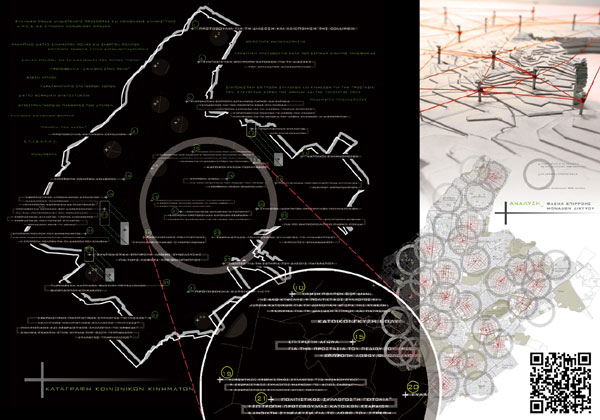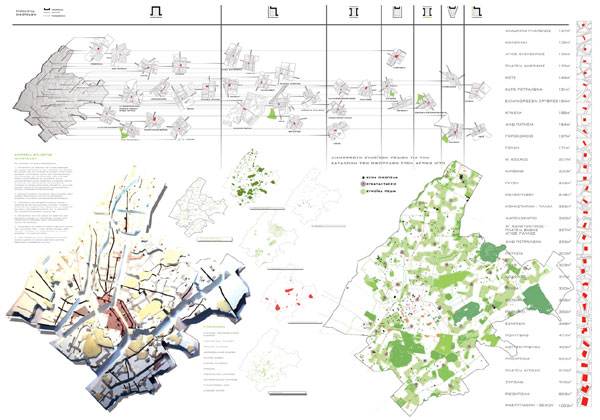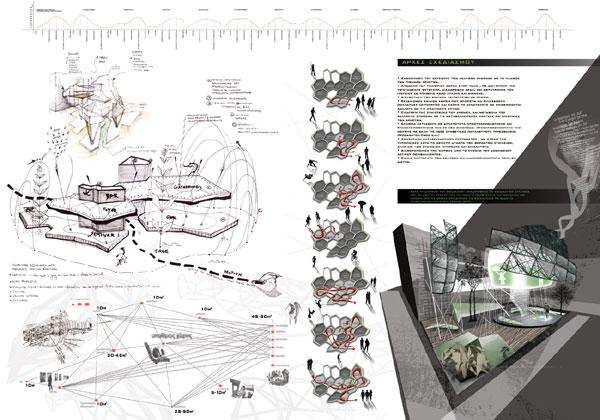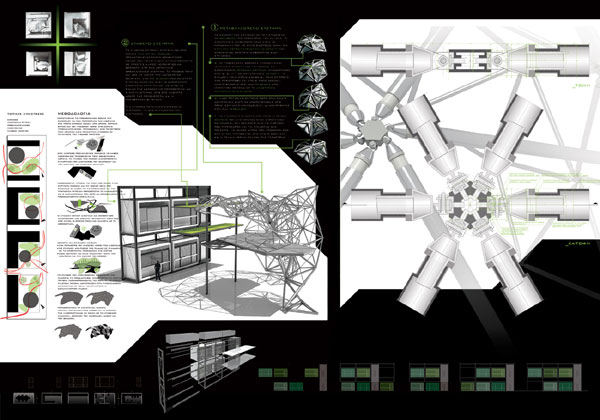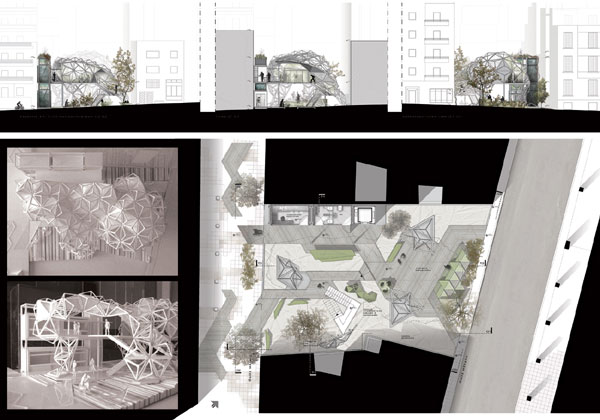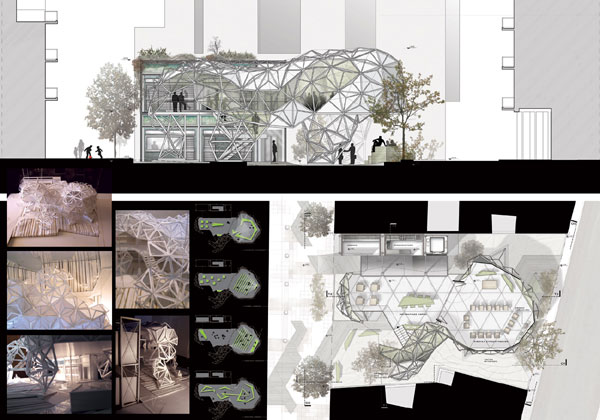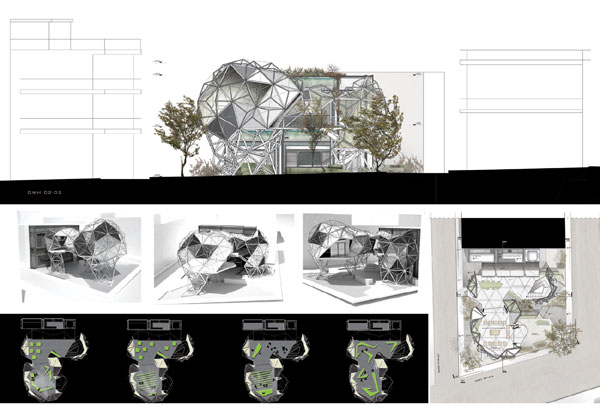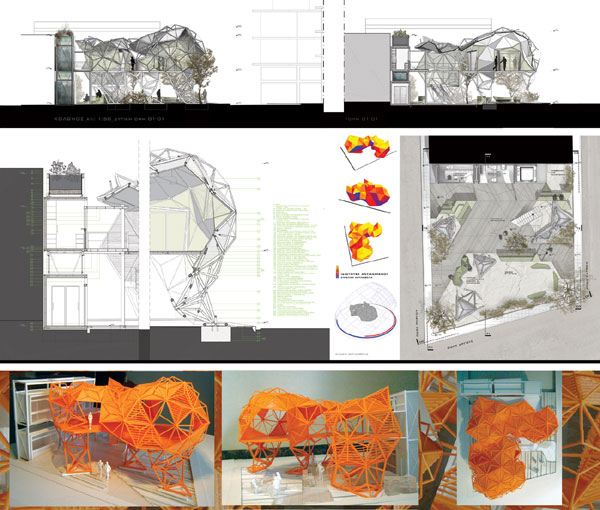STUDENTS PROJECTS
2010
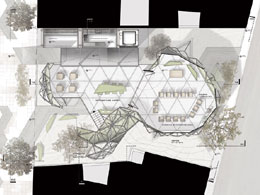
09 March, 2011
Nomadic n stallations
Designing a matrix of spaces in the Municipality of Athens in order to accommodate the gatherings of the local collectivities.
Students: Aliki Gkika, Dafni Lada, Natalia Michailidou
Supervisor: Dimitris Papalexopoulos
Consultan Professors: Nickos Belavilas, Giorgos Gyparakis
Short Description: We suggest the designing of spaces concerning located collectivities already activated in the local scale and their rational spreading across the metropolitan field, aiming to demonstrate a special identity in each neighborhood through creativity, dialog and collective activities. Our design principles are the ability of the reuse of materials, of the non-permanence and that of geometrical transformation.
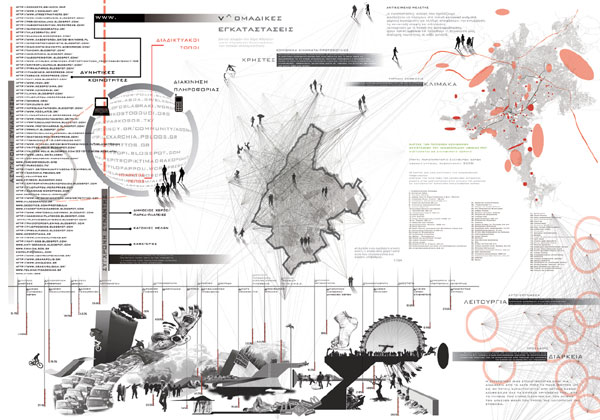
This diploma project consists of a research on urban social movements and proposes the creation of spaces capable to accommodate their ephemeral activities. It is an urban experiment aiming to allow a new form of common wealth to reveal, beyond 'public' and 'private'. This new form of common wealth is emerging through the collective actions of these movements and depends, at a large scale, upon the elements of communication, cooperation as well as of emotional and collective creativity.
In the first place the research focused on the existence and constitution principles of urban movements, emphasizing on the characteristic traits that formulate their constitution and their way of function. The city itself, by being a field of constant conflicts and negotiations, becomes the object catalyst of the collectivities emerging in order to claim their 'right to the city'.
A collectivity is determined by self-organization principles, and functions without central control and strict structure, according to the claims and purposes set in common by the participants. Despite the flexibility of their identity and variation of the number of users, consistency of problems emerging, establish the creation of collectivities a constant social phenomenon throughout time.
In the next level of the research, tracking and evaluation of these actions and initiatives activated in the urban tissue takes place, considering the municipality of Athens as the field of research. Movements appearing are local inhabitants' initiatives activated in the neighborhood scale, movements asserting free spaces in Athens and also initiatives triggered by a broader problem in the metropolis.
We suggest the designing of spaces concerning located collectivities already activated in the local scale and their rational spreading across the metropolitan field, aiming to demonstrate a special identity in each neighborhood through creativity,cooperation, dialog and collective activities.
We choose those regions in Athens where collective actions and activities are already localized, we articulate the criteria in order to choose the right spaces that will accommodating those, and through the layering of urban space diagrams, we formulate favorable fields to locate them. Having already rejected the idea of locating those spaces in existing parks or squares, we choose urban voids, part of the urban scape, directly in touch with existing free spaces and local centers, so they can comprise an extension of urban public space.
Multiplicity in the way collectivities function, variation in the number of the potential users and plurality of actions, as well as the temporary nature of these collectivities in general, create the need to find a space production tool, capable of alterations according to the different needs, but also able to be transferred in a new location, when this is considered expedient, taking into consideration the topological traits.
A shift from rigid building program towards the creation and understanding of relations among spaces through scenarios of use and function diagrams that translate into a range of surfaces.
Finally the need to create a uniform space emerged. A basic space of multiple uses, capable of accommodating the assemblies and gatherings of the members, but also susceptible to change depending on the various activities. The conference hall is encircled by auxiliary spaces of a certain surface, bar, WC, storage room, and technological equipment room. Installing digital technologies in space promotes the networking between the nodes.
Keeping up a safe distance from economic factors and conveyors of power, minimizing of construction cost is imposed. For this reason we designed a constructive system consisting of standard prefabricated elements, flexible as to assembly but also as to the capacity of change.
We invented a design tool, which by using a primary geometric element as basic, has the capacity to produce a variable number of solutions, this way translating the design variables into spatial relations between parts. Synthetical and also structural efficiency of the building is succeed through the combination of two different systems. The one is used for the construction of secondary spaces, while the other permits the creation of a more fluid transformable space.
The stable part of the construction consists of multiple identical units of prefabricated spaces (container type) sustained by an orthogonal steel system. This scaffold offers the capacity of linear expansion and also different settlement of spaces each time, covering though, the empty slots with planting.
The part of the structure than is susceptible to the transformation of it's geometry and has the ability to differentiate while being moved to another site, is a flexible lattice that consists of three different types of elements.
Two of the most typical cases of urban voids are chosen, those in Exarheia and Kolonos, in order to investigate the different form solutions emerging. The different topological variants (typology of field, formation of spaces geometry. Basic synthetical choice is the settlement of the basic functions in the first floor, in order to maintain any existing plantation in the ground floor and also to convert it into a garden offered to the city and its citizens. Design ambition is the coexistence in harmony with the blind side of adjacent building through the scaffold form, and simultaneously the differentiation of form from the rest of the urban built environment, offering this way to the sum of the spaces a common identity and recognition as network.
This assembling structure consists in the greater part of steel parts. In order to define the transparent and closed parts of the building and also place the shaders, the conditions of sunlight and ventilation, combining with the orientation and the desired views were put into consideration. The formation of ground space was made with wooden prefabricated parts, which give the users the capacity of assembling those themselves and also of changing them according to the mutations of their needs.
